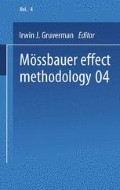Abstract
The tetrahaloferrates are high-spin, tetrahedral Fe (III) complexes and as such, they should have spherical electric field symmetry. Thus expects to observe only a small (or zero) quadrupole splitting derived from lattice effects for these anions. However, if chemical effects, such as hydrogen bonding, are present to destroy or distort the tetrahedral symmetry one can expect to see larger quadrupole splittings due to the distortion of the electric field symmetry. This paper describes the Mössbaure spectra at liquid-nitrogen temperature for a series compounds of the form (R)4−nNHnFeC14, where R is a straight-chain alkane. In the methyl series where R is -CH3, a single narrow line was observed for (CH3)4NFeCl4 and (CH3)NH3FeCl4. A quadrupole splitting of approximately 0.33 mm/sec was observed for (CH3)2NH2-FeCl4, and a single, broadened peak (Г = 0.54 mm/sec) was found for (CH3)3NHFeC14. For the corresponding butyl series, where R is -(CH2)3CH3, a splitting of approximately 0.33 mm/sec was observed in all cases except tetrabutyl, [CH3(CH2)3]4NFeCl4, where a narrow singlet was again obtained. To rule out the Possibility that the splittings were arising from lattice effects, the butyl compounds were dissolved in benzene and the spectra repeated at liquid-nitro temperatures. The Mössbauer spectrum of each compound in solution was identical with that obtained for the crystalline solid. Thus it appears that the quadrupole interactions are not of lattice origin but are caused by cation diatortion of the spherical symmetry. The most reasonable explanation appears to be hydrogen bonding, which exists both in the solid state and in solution. Correlations of the observed Mössbaure spectra with far-infrared data (where metal-halide stretching and bending vibration can be seen) are presented. Also other cations and their effects are discussed,as well as effects observed for other tetrahaloferrates such as FeBr4 -.
Access this chapter
Tax calculation will be finalised at checkout
Purchases are for personal use only
Preview
Unable to display preview. Download preview PDF.
References
R. J. Woodruff, J. L. Marini, and J. P. Fackler, Inorg. Cheap. 3: 687 (1964).
C. C. Chang, M.S. thesis, Louisiana State University, New Orlea La., Aug. 1967.
J. Danon, Rev. Mod. Phys. 36: 460 (1964).
J. J. Spijkerman, F. C. Ruegg, and L. May, Mössbauer Effect Methodology, Vol. 2, I. J. Gruverman, Ed. ( Plenum Press, New York, 1966 ).
A. P. Ginsberg and M. B. Robin, lnorg. Chem. 2: 817 (1963)
A. G. Maddock and L. O. Medeiros, Chem. Commun. 1967: 1067.
L. R. Walker, G. K. Wertheim, and V. Jaccarino, Phys. Rev. Letters 6:98 (1961)
L. A. Woodward and M. J. Taylor, J. Chem. Soc. 1963: 4473
Author information
Authors and Affiliations
Editor information
Editors and Affiliations
Rights and permissions
Copyright information
© 1968 Springer Science+Business Media New York
About this paper
Cite this paper
Clausen, C.A., Good, M.L. (1968). Effect of Cation on the Mössbauer Spectra of Tetrahaloferrate Anions. In: Gruverman, I.J. (eds) Mössbauer Effect Methodology. Springer, Boston, MA. https://doi.org/10.1007/978-1-4757-1550-7_11
Download citation
DOI: https://doi.org/10.1007/978-1-4757-1550-7_11
Publisher Name: Springer, Boston, MA
Print ISBN: 978-1-4757-1552-1
Online ISBN: 978-1-4757-1550-7
eBook Packages: Springer Book Archive

